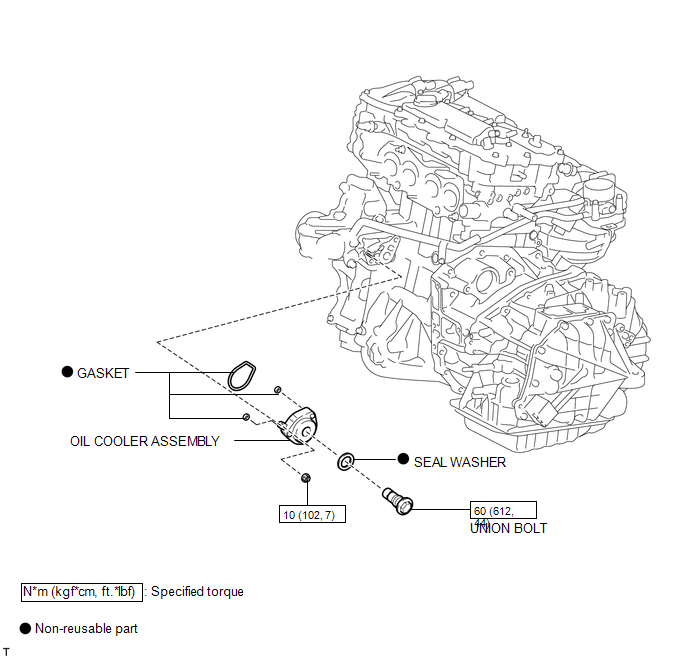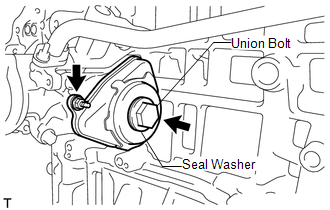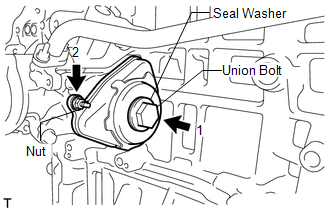Toyota Venza: Engine Oil Cooler
Components
COMPONENTS
ILLUSTRATION

Removal
REMOVAL
PROCEDURE
1. REMOVE EXHAUST MANIFOLD ASSEMBLY
HINT:
See page .gif)
2. DRAIN ENGINE OIL
.gif)
3. DRAIN ENGINE COOLANT
.gif)
4. REMOVE OIL COOLER ASSEMBLY
|
(a) Remove the nut, union bolt, seal washer and oil cooler assembly. |
|
(b) Remove the 3 gaskets from the oil cooler assembly.
Inspection
INSPECTION
PROCEDURE
1. INSPECT ENGINE OIL COOLER
(a) Visually check the engine oil cooler for cracks or damage.
If cracks or damage are found, replace the engine oil cooler.
Installation
INSTALLATION
PROCEDURE
1. INSTALL OIL COOLER ASSEMBLY
(a) Clean the oil cooler contact surface on the cooler mounting.
(b) Apply a light coat of engine oil to 3 new gaskets.
(c) Install the 3 new gaskets to the oil cooler assembly.
(d) Temporarily install the oil cooler assembly with the union bolt, nut and a new seal washer.
|
(e) Tighten the bolt and nut in several steps, in the sequence shown in the illustration. Torque: Union Bolt : 60 N·m {612 kgf·cm, 44 ft·lbf} Nut : 10 N·m {102 kgf·cm, 7 ft·lbf} |
|
2. INSTALL EXHAUST MANIFOLD ASSEMBLY
HINT:
See page .gif)
3. ADD ENGINE OIL
.gif)
4. ADD ENGINE COOLANT
.gif)
5. INSPECT FOR OIL LEAK
.gif)
6. INSPECT ENGINE OIL LEVEL
.gif)
 Lubrication System
Lubrication System
On-vehicle Inspection
ON-VEHICLE INSPECTION
PROCEDURE
1. INSPECT ENGINE OIL LEVEL
(a) Warm up the engine, stop it and wait 5 minutes. The engine oil level should
be between the low level mark ...
Other materials about Toyota Venza:
Precaution
PRECAUTION
1. EXPRESSIONS OF IGNITION SWITCH
The type of ignition switch used on this model differs according to the specifications
of the vehicle.
The expressions listed in the table below are used in this section.
Expression
Switc ...
Occupant Classification System Malfunction (B1650/32)
DESCRIPTION
The occupant classification system circuit consists of the center airbag sensor
assembly and occupant classification system.
If the center airbag sensor assembly receives signals from the occupant classification
ECU, it determines whether the ...
Precaution
PRECAUTION
1. NOTICE FOR INITIALIZATION:
NOTICE:
When disconnecting the cable from the negative (-) battery terminal, initialize
the following systems after the cable is reconnected.
System Name
See Procedure
Back D ...
0.1148



